Essential Arts: Art and pandemic — how artists and institutions are faring
Hello from the quarantine! I’m Carolina A. Miranda, staff writer at the Los Angeles Times, with your weekly dose of arts news and apocalypse looks. (Hint: We’re all about velvet.)
Essential image
Each week, I’m kicking off the newsletter with work by an artist whose show was closed due to the pandemic. This week, the work on view is by Sula Bermúdez-Silverman, who opened her first solo museum show in Los Angeles at the California African American Museum in late February, only to have it shuttered two weeks later.
Bermúdez-Silverman takes aspects of identity and turns them into art: transforming her family’s genetic data into colorful pie charts and embroidering vintage doilies with her own hair. The embroidered pieces feature words and objects, like the foot, above, which caught my attention when it came across my desk, for the ways in which it transforms mundane materials and gives them punch.
Catch a video of the artist talking about her work on CAAM’s website.
In the studio with L.A. artists
Or more like, outside the studio with artists. Times photographer Jay L. Clendenin and I teamed up to create a socially distant photographic portfolio that captures five L.A. artists at this moment in time. Sandy Rodriguez, Devon Tsuno, Monica Majoli and Tanya Aguiñiga very generously allowed us onto their driveways and into their backyards. And performance artist Ron Athey showed up rocking a velvet gown — mainly because he doesn’t want to die in his pajamas: “I’ll be looping in eternity in a bad look.”
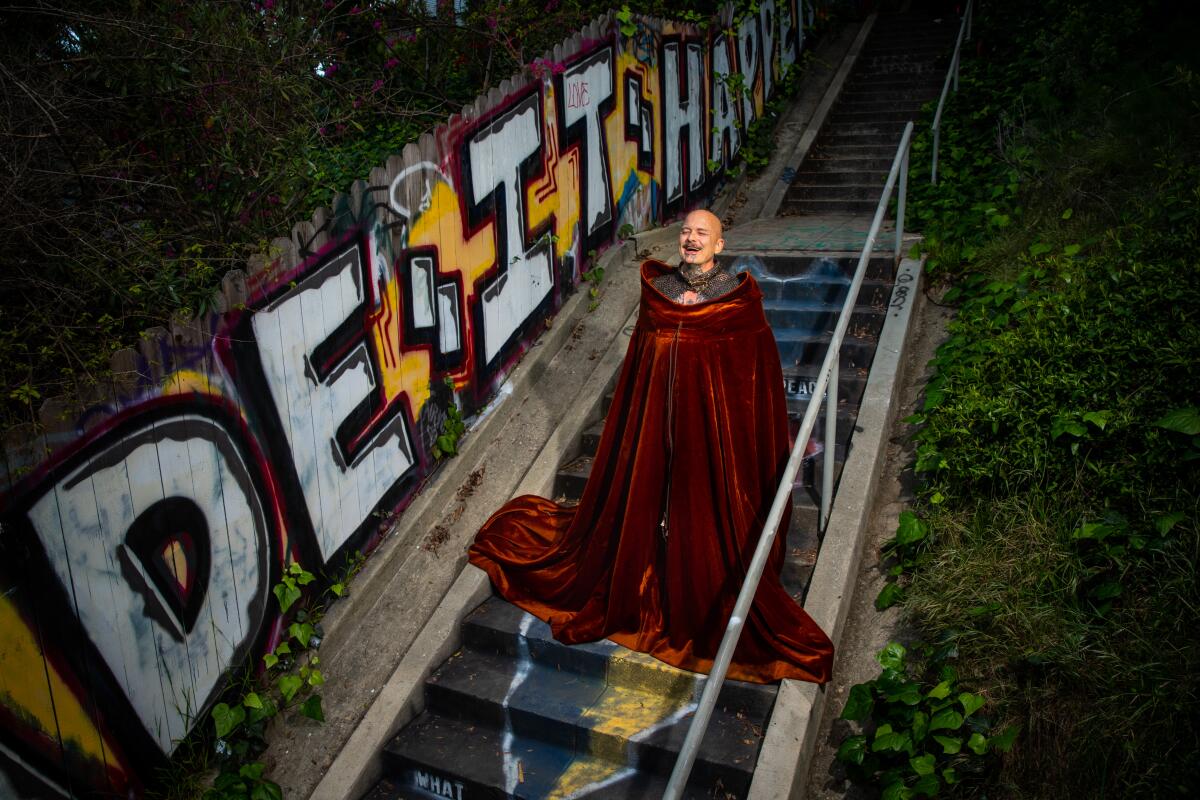
Art of corona
The good news first: In the middle of the epidemic, artists are finding countless ways to make work and lift spirits.
The Times’ Jessica Gelt reports that artist Alan Nakagawa is putting out an open call for haikus about coronavirus for a project that he will release in collaboration with the Orange County Museum of Art late next month.
Noted art photographers, including Catherine Opie, Stephen Shore and Todd Hido, are posting images of their quarantine experiences to Instagram.
Make the most of L.A.
Get our guide to events and happenings in the SoCal arts scene. In your inbox once a week.
You may occasionally receive promotional content from the Los Angeles Times.
The Geffen Playhouse is launching a series of original short performances titled “Geffen Stayhouse,” reports The Times’ Ashley Lee. These will be posted to its website and various social media channels every Wednesday and will feature fresh work by performers such as Jefferson Mays, Lauren Patten and Julia Sweeney.
In the meantime, Skylight Theatre has kicked off a series of online plays that are staged from various locations and streamed live. “Actors need to act, writers need to write, directors need to direct, and theaters need to keep doing what we do,” Gary Grossman, the theater’s producing artistic director, tells Lee.
Times theater critic Charles McNulty is smitten with Patti LuPone’s social media dispatches from her basement, which he describes as “U.S.O. care packages for show queens suffering from musical comedy withdrawals.”
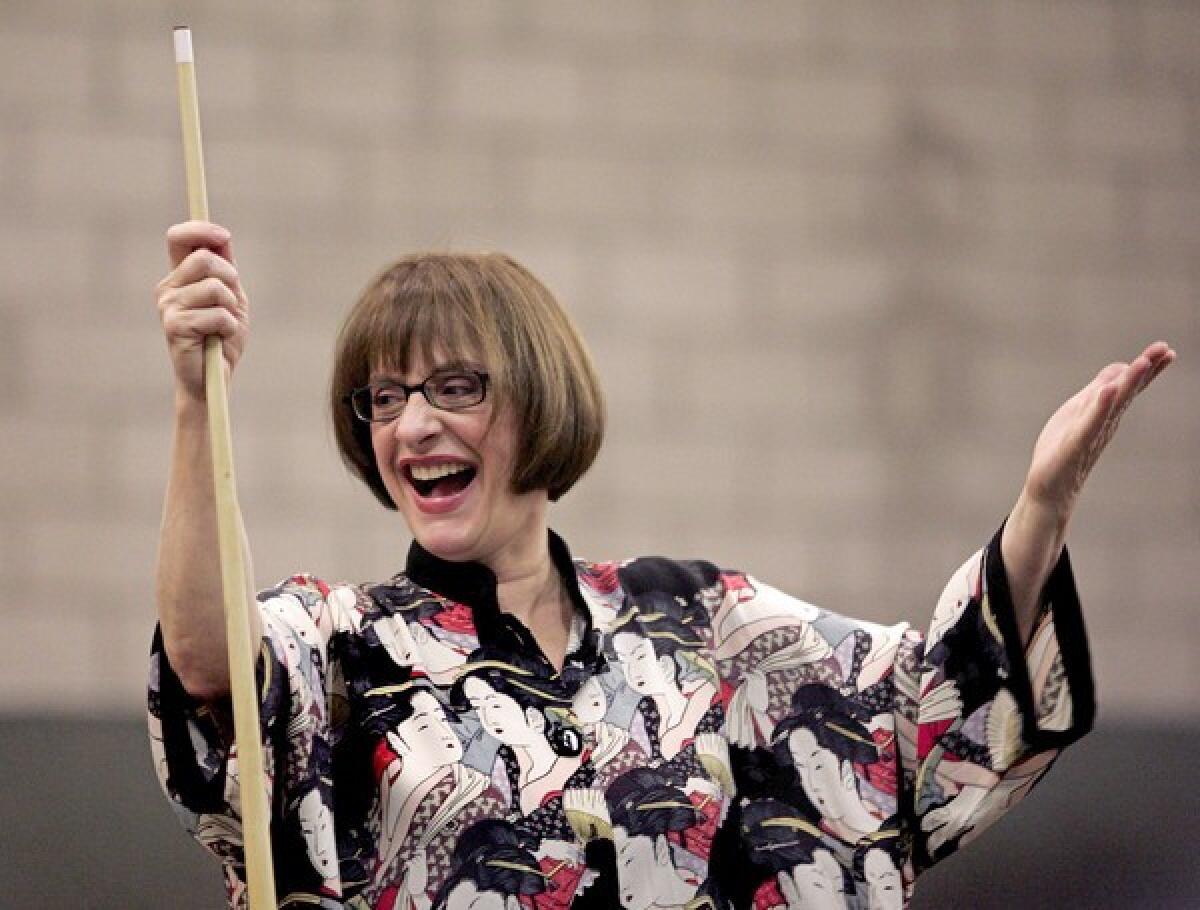
Times classical music critic Mark Swed has been wading through a bevy of online musical offerings, including a performance of Schumann’s Fantasy by Jeffrey Kahane, Zubin Mehta remotely conducting three Italian tenors in their home country, and the violinist Anne-Sophie Mutter, who has tested positive for the virus, performing a slow movement of Beethoven’s “Harp” with three string players in other locations. “The Germans have long had a word for it,” he writes. “Hausmusik, which is exactly what the term sounds like.”
He also reviews the video version of “Sweet Land,” by the Industry, which is now available to view on demand for $14.99. “It is the single best deal in all of opera right now,” Swed writes, “and that is taking into account the sudden riches of free opera streams from the world’s most illustrious companies.”
For Sean Griffin, who runs the avant-garde company Opera Povera, it began as a random idea posted to social media. Now more than 250 artists from around the world are gathering to perform a Pauline Oliveros opera online on Tuesday evening. Money raised will go to grants for U.S. musicians whose gigs were canceled by the pandemic.
I’ve been finding myself gravitating to dance videos as of late — something about music and movement without words seems really appealing at this moment. That includes the ebullient videos shared by Tony-award winning actor Robbie Fairchild (who used to dance with the New York City Ballet) and his roommate Chris Jarosz, an independent dancer and choreographer, as well this wonderful socially distant choreography from the Martha Graham Dance Company.
You can support the Martha Graham dancers through their relief fund.
Corona and the arts
Now the bad news: the COVID-19 pandemic continues to pummel the arts and artists economically.
The Times’ Makeda Easter looks at how the cancellation of concerts, shoots and events has hit hard among independent choreographers and commercial dancers, contract workers who often don’t have benefits of any kind to fall back on. “It’s the new reality for L.A.’s commercial dance world,” writes Easter, “an already exclusive and fragile industry.”
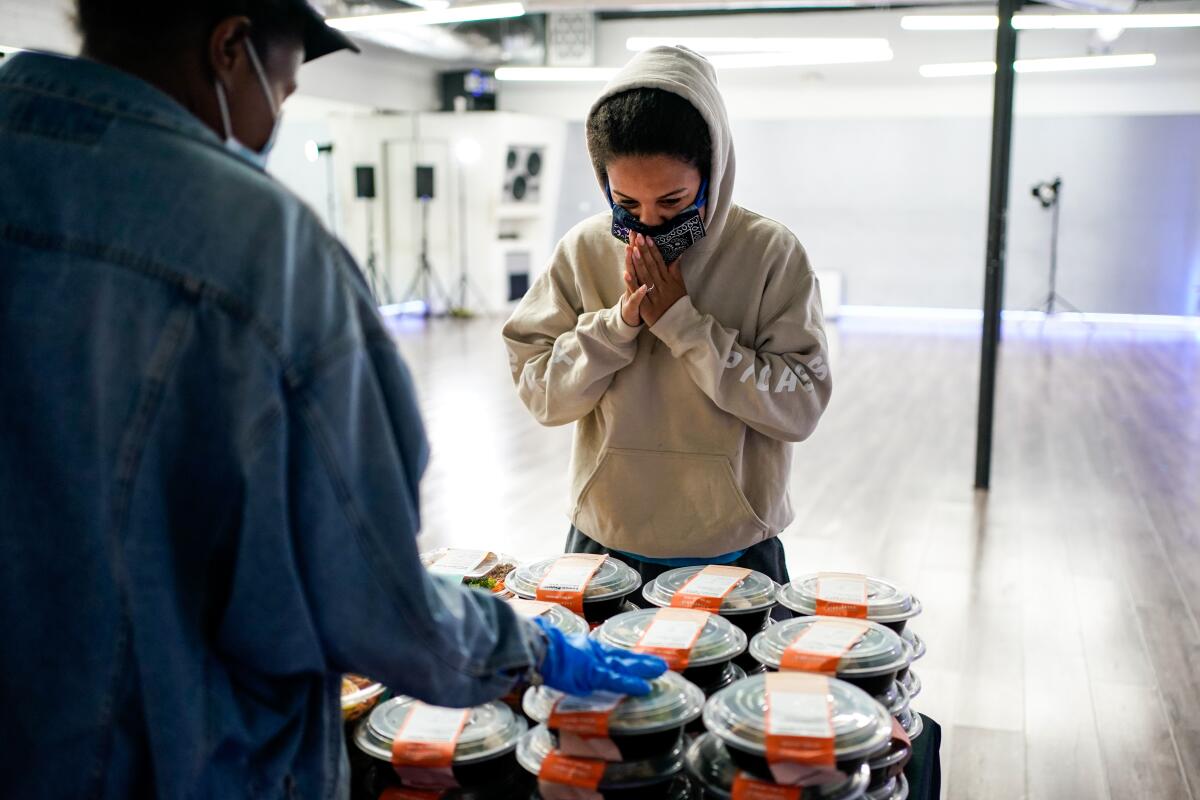
The Center Theatre Group has suspended all shows until the fall and furloughed about half of its staff through early August. Furloughed employees will continue to receive benefits and remaining staff will face paycuts. Coronavirus has been brutal for theaters: ticket sales account for more than 75% of the Center Theatre Group’s annual revenue.
The Museum of Contemporary Art furloughed and instituted paycuts for most of the staff. About half of full-time employees were furloughed, reports The Times’ Deborah Vankin. And director Klaus Biesenbach is taking a large pay cut. In an email, Biesenbach described the situation as a “slow-burning catastrophe.”
MOCA’s employee union has launched a relief fund for workers who have lost their jobs.
In addition, the Annenberg Space for Photography in Century City has laid off eight staffers, including seven full-time employees and one temp.
Andrew J. Campa looks at what the pandemic might mean for small L.A. institutions, like the Altadena Bunny Museum and the Valley Relics Museum. “We have no revenue coming in, no endowment to dip into,” says Kori Capaldi, executive director of the historical Heritage Square Museum in Montecito Heights.
Enjoying this newsletter? Consider subscribing to the Los Angeles Times
Your support helps us deliver the news that matters most. Become a subscriber.
In the Bay Area, the Exploratorium cut hours, laid off part-time workers and implemented furloughs and paycuts. And the San Francisco Museum of Modern Art is laying off or furloughing more than 300 workers. In addition, director Neal Benezra and other members of management will take pay cuts.
“We have been fortunate to be able to keep our staff on full compensation for seven weeks after we closed,” wrote Benezra in a statement, “but we now have to look to the future and make the painful decision to temporarily decrease the size of our team.”
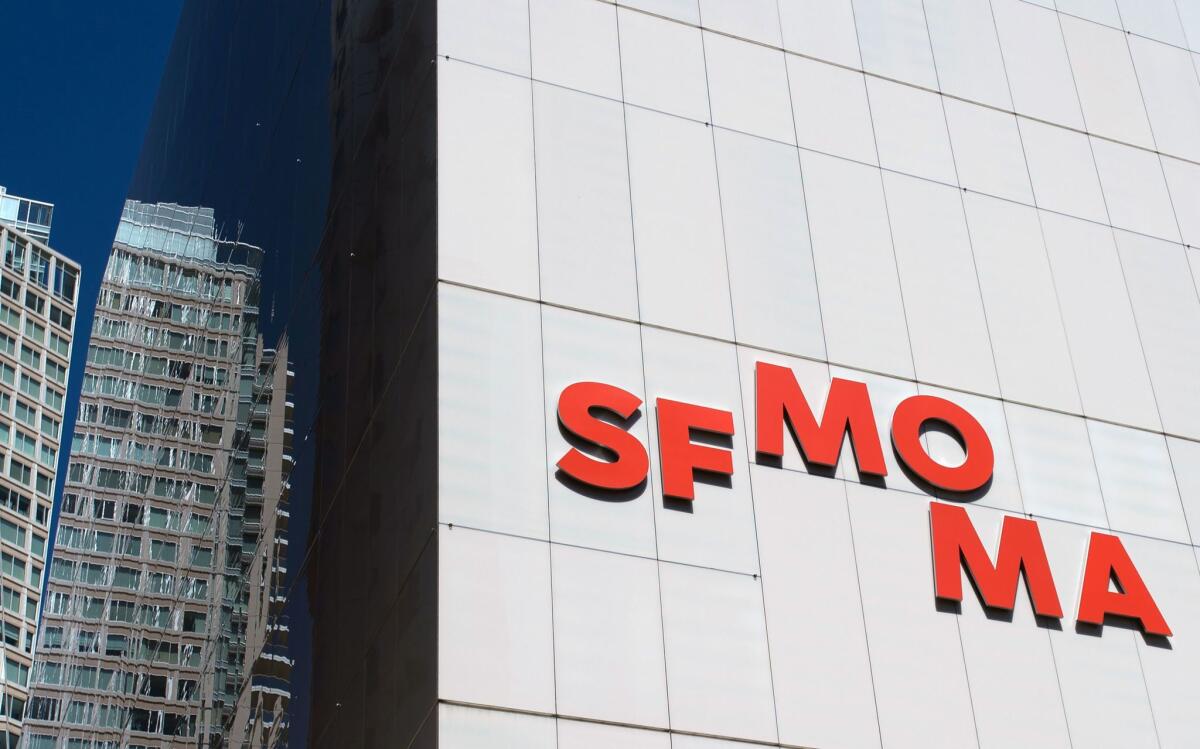
In New York City, the Whitney Museum laid off 76 employees. Plus, senior staff, including director Adam Weinberg, will be taking a pay cut. Weinberg said he anticipates a shortfall of at least $7 million by the end of the fiscal year.
The Metropolitan Museum of Art, in the meantime, will extend staff pay until May 2. Originally, they were only going to guarantee salary payments through April 4. The museum is exploring the possibility of temporarily dipping into its endowment to get it through the pandemic.
Art + Museum Transparency has been keeping track of museum layoffs around the country in a long (and growing longer) Twitter thread.
Some needed relief
Numerous organizations have begun to spring into action to help offer relief to artists and organizations.
The J. Paul Getty Trust created a $10 million COVID-19 relief fund for visual arts organizations based in L.A. County. As part of this, the CCF Fellowship for the Visual Arts grant will this year be repurposed as an emergency support grant for artists.
The Warhol Foundation is offering $1.6 million in emergency grants to artists in 16 U.S. cities while the Helen Frankenthaler Foundation is committing $5 million for crisis relief, including individual artist grants and support to organizations while they are closed.
Anonymous Was a Woman has announced $250,000 in emergency grants for female artists over 40 in the U.S. and L.A.’s Women’s Center for Creative Work is offering emergency COVID-19 health grants for low-income artists living in four Southern California counties.
My colleague Anousha Sakoui has a great round-up of organizations assisting performers and other workers in various areas of the entertainment industry. And Makeda Easter comes through with a list of resources for those in the fine arts.
The next museums
Sunday Calendar gives us a glimpse of how two rising museums will transform the cultural landscape of Los Angeles — changes that were underway before the coronavirus outbreak and will provide new places to explore once the pandemic is long behind us.
The half-built structure near the L.A. Memorial Coliseum might resemble a “damaged Millennium Falcon undergoing repairs,” writes architecture contributor Sam Lubell. But it’s actually the Lucas Museum of Narrative Art by architect Ma Yansong, founder of the firm MAD. Lubell profiles the architect, a man of few words who likens his museum structure to a shapeless cloud. His work isn’t always a hit, however. Chicago Tribune architecture critic Blair Kamin once likened the architect’s proposal for a Lucas museum in Chicago as “a giant lump.”
But as this gallery of 11 buildings by the architect’s MAD firm, those lumps are mysterious and intriguing. Lubell says that Ma, like Lucas, “channel a poetic past and a visionary future for inspiration.”
Also rising next to the the much-debated construction happening at the Los Angeles County Museum of Art, is the Renzo Piano-designed Academy Museum of Motion Pictures, which is still set to open in December. Times culture writer Deborah Vankin sat down with museum director Bill Kramer and got a preview of what visitors will see inside the galleries.
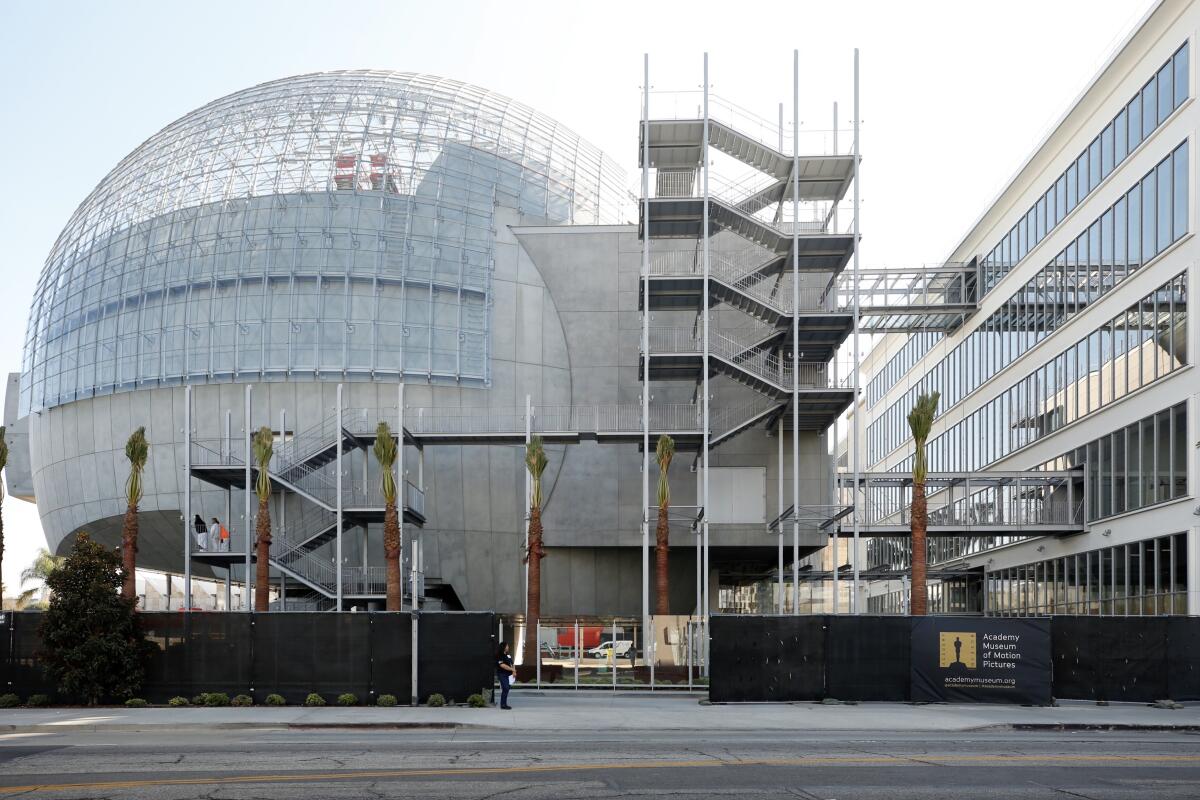
See you at the movies
Times film critic Kenneth Turan is retiring. When our newspaper’s offices were still located in downtown L.A., I had the good fortune of sitting next to Kenny, as he was known in the newsroom, and I couldn’t have had a better cubicle-mate: He was perpetually good natured, and we regularly shared taco lunches.
My colleague Justin Chang pays tribute to an incredible career. And Kenny leaves us with his list of 14 films that will offer some psychological balm during these troubled times. “Because being useful as a critic ... has always been one of my guiding principles,” he writes, “it feels especially fitting that my final piece is not ruminative or filled with reminiscences but very much in that pragmatic spirit.”
Time to get watching.
Best arts online
Matt Cooper has been blazing the keyboards to keep us up-to-date on the best culture to view while social distancing. This includes Margaret Batjer of the Los Angeles Chamber Orchestra playing solo pieces by Bach on violin, a musical farce courtesy of London’s National Theatre and a new audio release of Bizet’s “Carmen” by L.A. Opera.
Find Cooper’s listings on The Times’ Things To Do: Arts & Culture page on a daily basis.
Bonus: The Times has put together a guide to everything there is to do on the internet. So. Much. Content.
In my little neck of the internet woods, I’d like to recommend Kimberly Drew’s new newsletter, Something I Saw. Each day, she emails you a single work of art with a related story. Informative and enjoyable. There are free and subscriber versions.
Passages
Gerald Freedman, the director behind countless works of theater, including the original “Hair,” has died at the age of 92 of kidney failure.
David C. Driskell, whose 1976 exhibition at LACMA, “Two Centuries of Black American Art: 1750-1955,” helped break ground in the scholarship of African American art, has died at 88.
In the news
— The California Historical Society has been doing some great historical posts during this time, such as this interesting piece about an improvised bubonic plague hospital at a San Francisco racetrack in the early days of the 20th century.
— The Autry Museum of the American West has donated its stock of personal protection equipment to L.A. hospitals.
— Writer Matt Stromberg and curator J. Patrice Marandel sound off on the LACMA building plan.
— Karrie Jacobs takes on the (now-shuttered) Rem Koolhaas show at the Guggenheim: “While it is encyclopedic in its aspirations, it is Wikipedic in its execution.”
— Gia Kourlas on how the pandemic has affected the choreography of everyday life.
— The Getty Museum put out a call on social media asking people to remake famous artworks using household items and the results are clever and adorbz. See the full Twitter thread here.
— Taylor Lorenz says you don’t have to be productive during a pandemic. Whew.
And last but not least ...
A disaster dégustation: I write about five disaster movies and the meals to go with them — with special appearances by alien contagions, Cuban zombies and Kraft mac and cheese.
The biggest entertainment stories
Get our big stories about Hollywood, film, television, music, arts, culture and more right in your inbox as soon as they publish.
You may occasionally receive promotional content from the Los Angeles Times.




